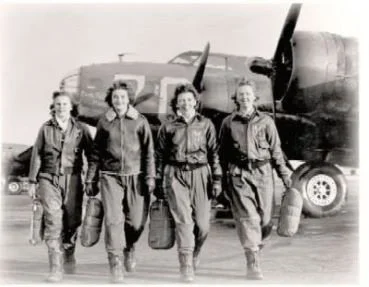High Flyers: A Short History of Women in Aviation
Arts Alive
Quick, name a famous female pilot. You said ‘Amelia Earhart’. Name another. Specifically, name a Canadian. Drawing a blank?
Well, Canada has a rich tradition of female aviators. A traveling exhibit from the National Museum of Aviation in Ottawa, High Flyers, illustrates the role women have played in Canada’s aviation history. The hope is that sharing this important history may spur young women to follow in these pioneers’ steps, and to look at aviation as a field that can provide many opportunities.
The exhibit celebrates this group of strong-willed pioneers and pays tribute to Canadian women in aviation from before World War II through to today.
There are numerous interesting characters introduced, and stories told. For example, in 1919, Madge Graham, who was married to Canada’s first bush pilot, Stuart Graham, served as navigator on a five-day voyage in which Madge, Graham and a mechanic flew a water-logged wooden flying boat, at tree level, from Dartmouth Nova Scotia to Grand’Mere Quebec (750 kilometres). The escapade elicited this from the American Rear Admiral Byrd, who specialized in feats of exploration: “Flying seaplanes over land is suicide, and taking a woman along is criminal!”
Back then, female aviators were a novelty—the press called them ‘Flying Flappers’, ‘Angels’ and ‘Sweethearts of the Air’. Normally, pilots wore heavy gear as protection from fumes, noise and the elements. But when photographers were around, famous female aviators such as Amelia Earhart and Jacqueline Cochran wore blouses, scarves, make-up and tailored slacks. Their worry was that figure-veiling suits would repel non-flying women, and it was believed that if women looked fresh and glamorous after a flight, it would show other women that flying was safe and restful.
By the 1930s, women pilots were attracting more attention. In 1936, the Vancouver-based Flying Seven became Canada’ first women’s flying club. It was this group that conducted the 1939 ‘bomphlet raid’ on Vancouver, dropping 100,000 pamphlets pleading for “dimes or dollars to buy our boys more planes”.
World War II should have been a boon for female aviators. Instead, the Canadian military deemed the job of pilot as inappropriate for women. One pilot, Helen Harrison, applied to the RCAF with an instructor’s license and a seaplane rating, multi-engine and -instrument endorsements, experience of flying civil and military craft in three countries, and 2,600 flying hours. She was turned away in favour of men with little more than 150 hours to their credit.
So women aviators worked to ‘back the attack’. Some taught flying and navigation—until the RCAF trained male teachers. Five Canadian women headed to Britain and joined the Air Transport Auxiliary, a civilian organization that ferried aircraft to squadrons, factories and storage units around Britain. Women were involved in aircraft assembly; Elsie MacGill was the aeronautical engineer who supervised the Canadian production of 2,000 Hawker Hurricanes. Finally, in 1941, the RCAF began to admit women, mainly as aerial photographers. And the CWAF (the RCAF’s women’s division), carried the motto: “They serve that men may fly”.
Post-war, things didn’t get any better. Marion Orr, who was inducted into the Aviation Hall of Fame in 1981, had to go all the way to the Prime Minister’s Office for approval to open her own school and airfield. Stewardesses were in demand, but interviews involved leg and teeth inspections, and marriage meant instant dismissal. Trans-Canada Airlines, Pacific Western Airlines and Canadian Pacific Airlines told Helen Harrison that she was too weak to handle the controls. Dawn Dawson made it as far as the interview—only because the receptionist had spelled her name ‘Don’.
Gradually, things improved—after a lawsuit or two. Lorna DeBlicquy, a flying instructor, bush pilot and flight-test examiner who started flying at age 15 and had 6,000 hours to her credit, sued Air Canada after two of her male students were hired and she was denied an interview on the basis that she was too short and would require a specially-designed uniform. In 1977, DeBlicquy became Canada’s first civil aviation inspector and, in 1995, was awarded the Order of Canada.
Finally, in 1973, Trans-Air hired Rosella Bjornson as the first and only female in a field of 2,800 pilots. Then other commercial airlines began hiring women. Today, although some still face prejudice and even hostility, increasing numbers of female pilots are working in military and civil aviation, and still more are air-traffic controllers and engineers. So it’s been a bumpy ride. But every female aviator believed the struggle was worthwhile. As Amelia Earhart said: “If enough of us keep trying, we’ll get someplace.”



